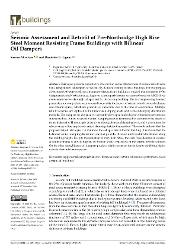| dc.contributor.author | Akcelyan, Sarven | |
| dc.contributor.author | Lignos, Dimitrios G. | |
| dc.date.accessioned | 2023-10-19T15:12:03Z | |
| dc.date.available | 2023-10-19T15:12:03Z | |
| dc.date.issued | 2023 | |
| dc.identifier.issn | 2075-5309 | |
| dc.identifier.uri | https://doi.org/10.3390/buildings13010139 | |
| dc.identifier.uri | https://hdl.handle.net/20.500.12469/5327 | |
| dc.description.abstract | This paper presents quantitative information on the effectiveness of seismic retrofit solutions using bilinear oil dampers for seismically deficient existing tall steel buildings. For this purpose, a benchmark 40-story steel space moment-resisting frame building is studied that represents 1970s design practice in North America. Rigorous seismic performance assessment based on ASCE 41 recommendations reveals a high collapse risk for the existing building. The local engineering demand parameters are comprehensively assessed to quantify the impact of seismic retrofit on steel columns and column splices, which are particularly vulnerable due to the time of construction. Multiple retrofit schemes are explored with numerous damping levels and vertical damping distribution methods. The dampers are designed via a recently developed multi-degree-of-freedom performance curves method. A new balanced vertical damping method is proposed to account for the effects of frame inelasticity. This strongly depends on the supplemental damping level, and it determines the effectiveness of the employed vertical damping distribution method. The results indicate that the proposed retrofit strategies can minimize the collapse risk of the tall building. It is shown that the balanced vertical damping distribution method provides the most uniform drift distribution along the building height. Despite the reduction in story drift ratios, the axial force demand in exterior columns remains relatively high in the bottom stories regardless of the seismic retrofit solution. On the other hand, bilinear oil dampers produce relative constant forces despite exhibiting higher velocity demands than expected. | en_US |
| dc.description.sponsorship | Fonds de recherche du Quebec Nature et technologies [2013-NC-166845]; Natural Sciences and Engineering Research Council of Canada (NSERC); Ecole Polytechnique Federale de Lausanne (EPFL); Individual Research Fund of Kadir Has University | en_US |
| dc.description.sponsorship | This research was supported by Fonds de recherche du Quebec Nature et technologies (Grant No. 2013-NC-166845), Natural Sciences and Engineering Research Council of Canada (NSERC), Individual Research Fund of Kadir Has University, and internal funding from Ecole Polytechnique Federale de Lausanne (EPFL). The findings in this paper are those of the authors and do not necessarily reflect the view of the sponsors. | en_US |
| dc.language.iso | eng | en_US |
| dc.publisher | Mdpi | en_US |
| dc.relation.ispartof | Buildings | en_US |
| dc.rights | info:eu-repo/semantics/openAccess | en_US |
| dc.subject | Viscous Dampers | En_Us |
| dc.subject | Performance | En_Us |
| dc.subject | Design | En_Us |
| dc.subject | Protection | En_Us |
| dc.subject | Splices | En_Us |
| dc.subject | Models | En_Us |
| dc.subject | supplemental damping | en_US |
| dc.subject | bilinear oil dampers | en_US |
| dc.subject | seismic retrofit | en_US |
| dc.subject | collapse risk | en_US |
| dc.subject | performance-based design | en_US |
| dc.subject | tall buildings | en_US |
| dc.title | Seismic Assessment and Retrofit of Pre-Northridge High Rise Steel Moment Resisting Frame Buildings with Bilinear Oil Dampers | en_US |
| dc.type | article | en_US |
| dc.authorid | Akcelyan, Sarven/0000-0001-5811-5546 | |
| dc.identifier.issue | 1 | en_US |
| dc.identifier.volume | 13 | en_US |
| dc.department | N/A | en_US |
| dc.identifier.wos | WOS:000917056700001 | en_US |
| dc.identifier.doi | 10.3390/buildings13010139 | en_US |
| dc.identifier.scopus | 2-s2.0-85146652705 | en_US |
| dc.institutionauthor | N/A | |
| dc.relation.publicationcategory | Makale - Uluslararası Hakemli Dergi - Kurum Öğretim Elemanı | en_US |
| dc.khas | 20231019-WoS | en_US |
















